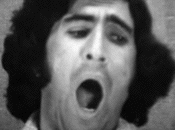-
-
- Staggeringly simple films: a man itching his
back, a man thinking, a man yawning, but like
the works of Samuel Beckett, these minute
gestures stand in as grand statements of the
human condition, akin to the films of Bas Jan
Ader and Marcel Broodthaers.
-
- Rarely seen, these are gems of Armenian
avant-garde art and are gestures of deviance;
political commentaries that positively reverse
the image of isolation current among cultural
pessimists, as a seizure of space in a world of
standardization, of the mass society.
-
- Hamlet Hovsepian's film is not only the
result of a small revolt against the deadly
passivity of this society. The reduction it
carries out, its silence, gives a universal turn
to the meaning of emptiness, to the abstract
space, and the frequently extended time.
-

-
-
- In the late sixties and early seventies,
Hovsepian, who was then living in Moscow for a
while, was in close contact with the left-wing
aesthetic avant-garde in the capital. But he
differed from it in his artistic approach. As
opposed to aesthetic critique as work in a
symbolic space that draws on the formal
apparatuses of everyday and ruling culture, as
it is always incorporated, reflected, in Moscow
conceptual art of the time, in his film, which
was made after he had left Moscow, Hovsepian
inserts the social back into the subjects. This
conjuring trick - which, in one bold move,
dispenses with the oppressive burden of the
hollow ideological kitsch of the bureaucratic
culture of the Brezhnev area as an aesthetic
projection surface and withdraws to the stage of
abstract, everyday acts - and the completely
unspectacular camera work have no parallel
anywhere else in the Soviet counter-avant-garde
of those years. In the mid-seventies, Hovsepian
returned to Armenia, to his studio in the small
village of Ashnak, where he has lived ever
since. There, in voluntary reclusion, he began
consistently to create a body of conceptual
works. As well as this film, which was conceived
and filmed on one of the rural afternoons in
Ashnak, and is today only available as a copy
urgently in need of conservation, he created a
number of installations and interventions on an
equally reduced scale: a few plants in plastic
bags in front of a house wall, newspaper that
draws a line in the landscape along a slope at
the foot of Mount Aragats. And later, he
produced a series of paintings following the new
conventions of Perestroika art. In the Caucasus,
Hovsepian is seen by many artists of the middle
and younger generation as one of the erratic
avant-garde figures of the seventies. Arman
Grigorian once paradoxically and ironically
called Hovsepian's studio "The Kitchen" of the
Soviet Caucasus. Not completely without reason.
This one film alone places the filmmaker
Hovsepian in a genealogy in which the films of
the New York underground are also inscribed.
Washing long hair, biting nails, yawning -
gestures of deviance that positively reverse the
image of isolation current among cultural
pessimists, as a seizure of space in a world of
standardization, of the mass society, as
cultural critics called it in those years.
Hamlet Hovsepian's film is not only the result
of a small revolt against the deadly passivity
of this society. The reduction it carries out,
its silence, gives a universal turn to the
meaning of emptiness, to the abstract space, and
the frequently extended time.
-
-
Georg Schöllhammer
-
- Head 1975, 16mm, 12 minutes
-
- Yawning 1975, 16mm, 2:20 minutes
-
- Itch 1975, 16mm, 4:30 minutes
-
- Untitled 1976, 16mm, 4:25 minutes
-
- Thinker 1975-6, 16mm, 6:40 minutes
-
|
